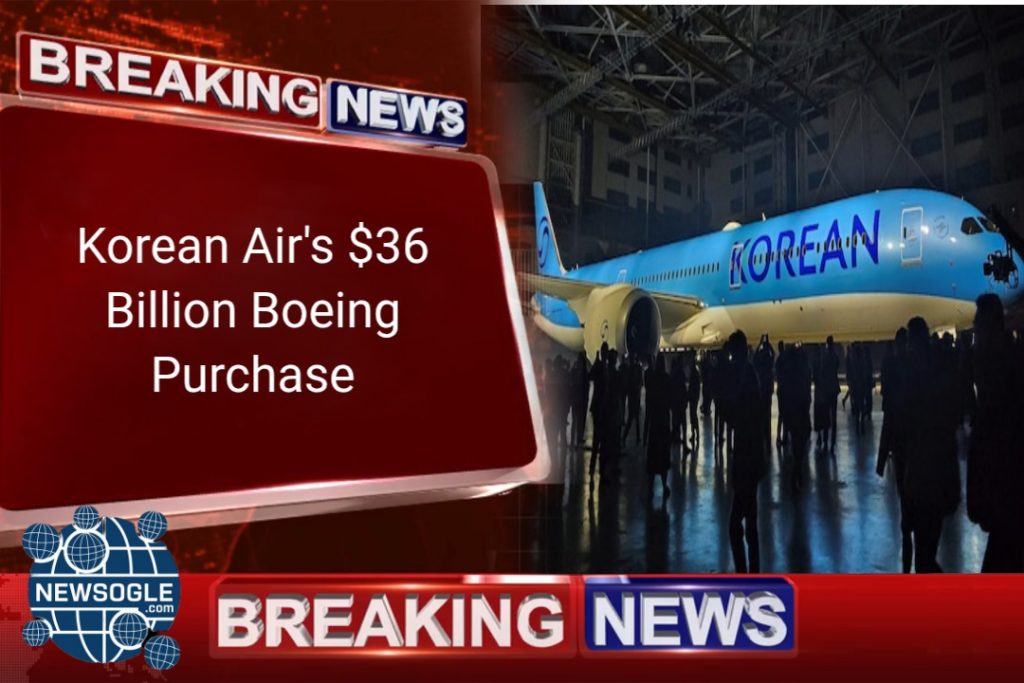
SEATTLE, WA – In a monumental move that underscores the enduring partnership between the United States and South Korea, Korean Air has finalized a colossal $36 billion deal with Boeing to acquire 103 new commercial jets. The landmark agreement, announced from Boeing’s headquarters, marks a significant investment in the future of air travel and a powerful statement of confidence in the U.S. aerospace industry. This transaction is not merely a fleet modernization for the South Korean flag carrier; it is a strategic maneuver that promises to create and sustain thousands of jobs in the United States while aligning with the broader geopolitical landscape shaped by recent trade policies. The sheer scale of the deal—the largest in Korean Air’s history—signals a new era for both companies and has the potential to ripple across the global aviation sector for decades to come.
The Details of the Deal: A Fleet for the Future
The $36 billion agreement is a comprehensive package that includes a mix of Boeing’s most advanced and fuel-efficient aircraft. The order is reportedly composed of a large number of single-aisle 737 MAX jets, which are a workhorse of short-to-medium-haul routes, and a substantial number of wide-body 787 Dreamliners, known for their long-range capabilities and passenger comfort. This dual-pronged approach will allow Korean Air to modernize its domestic and regional routes with the 737 MAX, replacing older, less efficient models, while simultaneously expanding its international long-haul network with the state-of-the-art 787s. The deal also includes options for additional aircraft, which could see the value of the transaction increase even further in the coming years.
Boeing, a company that has faced its share of challenges in recent years, sees this deal as a major boost. The order provides a much-needed backlog and a clear signal of market confidence in its product line. For its part, Korean Air is making a long-term bet on the continued growth of international travel. The airline, a key player in the Asia-Pacific market, is positioning itself for a future where passenger demand is expected to surge, particularly on routes connecting Asia to North America and Europe. The new aircraft will not only enhance the airline’s operational efficiency and reduce its carbon footprint but also significantly improve the passenger experience with more modern cabins and amenities.
Impact on U.S. Jobs: A Win for American Manufacturing
One of the most immediate and tangible impacts of this deal is its effect on the U.S. economy, particularly on the American aerospace manufacturing sector. The production of 103 new commercial aircraft requires a massive workforce, from engineers and designers to factory workers and supply chain professionals. The deal is expected to support and create thousands of jobs across the United States, providing stability to a vital industry that is a cornerstone of American manufacturing.
Senior officials from the U.S. government and executives from both Boeing and Korean Air have highlighted the job-creation aspect of the agreement. The transaction is a direct example of a foreign investment that fuels domestic economic growth. For communities surrounding Boeing’s manufacturing facilities in states like Washington and South Carolina, this order translates into a long-term pipeline of work, ensuring job security and economic prosperity. The deal also benefits a vast network of U.S. suppliers who provide components and systems for Boeing’s aircraft, further spreading the economic impact across the country.
Alignment with U.S. Trade Policy and Geopolitics
The timing and scale of this deal are also noteworthy given the current political and economic climate. It comes at a time when the United States, under the leadership of President Donald Trump, has placed a strong emphasis on fair trade and has exerted pressure on its trading partners to reduce trade imbalances and invest in American goods and services. While the specifics of the negotiations are confidential, the large-scale purchase of U.S.-manufactured jets by a key ally like South Korea fits neatly into the administration’s “America First” and fair-trade narratives.
The deal can be seen as a strategic move that strengthens the economic ties between the two countries, reinforcing a relationship that is critical for regional stability and global trade. It sends a clear message that despite trade tensions in other sectors, the partnership in aviation and high-tech manufacturing remains robust. For Korean Air, this investment in American technology not only modernizes its fleet but also serves as a gesture of goodwill that could help smooth over any potential trade-related issues.
Furthermore, in an era of heightened competition from rival aerospace manufacturers, particularly from Europe and China, this deal solidifies Boeing’s position as a dominant force in the global market. It demonstrates that Boeing’s products are still highly sought after and that the company can secure massive orders even in a challenging economic environment. The deal is a testament to the quality and reliability of U.S.-made aircraft and a boost to the country’s economic standing on the world stage.
The Future of Aviation and Korean Air’s Strategic Vision
Korean Air’s decision to commit to a fleet of 103 new aircraft is a bold bet on the future of air travel. The airline’s long-term strategy is focused on expanding its international presence, particularly on high-demand routes. The new 787 Dreamliners, with their superior fuel efficiency and extended range, will allow Korean Air to open new routes and increase frequencies on existing ones, giving it a competitive edge against other major carriers. The 737 MAX, meanwhile, will provide the airline with the flexibility to serve a growing network of short-to-medium-haul destinations efficiently.
The aviation industry is at a crossroads, with environmental concerns and the need for greater efficiency driving fleet modernization. Older aircraft, while still functional, are less fuel-efficient and produce more emissions. By investing in the latest generation of Boeing jets, Korean Air is not only improving its operational performance but also making a strong statement about its commitment to environmental sustainability. The new aircraft will help the airline reduce its carbon footprint and meet the industry’s increasingly stringent environmental regulations.
In conclusion, Korean Air’s $36 billion deal with Boeing is a landmark agreement that will have far-reaching consequences. It is a win for the U.S. economy, providing a significant boost to the aerospace manufacturing sector and supporting thousands of jobs. It is a strategic move that strengthens the economic and political ties between the United States and South Korea. And for Korean Air, it is a bold investment in the future, a clear sign of the airline’s ambition to remain a leading player in the dynamic and competitive world of global aviation. The transaction serves as a powerful symbol of how international commerce can be a force for economic growth and international cooperation.






